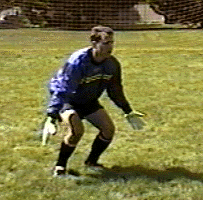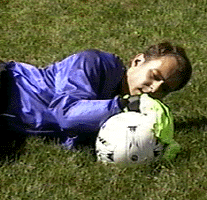
|
"Outstanding keeper instruction. This is a must for goalkeepers and coaches." — Ottawa Internationals S.C. web site, Ottawa, Canada |

|

|
|
|
Top |
Next: Distribution
|
The goal is soccer's fiesta: the striker sparks delight and the goalkeeper, a wet blanket, snuffs it out.
—Eduardo Galeano, Soccer in Sun and Shadow
| CONTENTS | TRAINING SESSIONS |
|---|---|
|
Positioning
Timing The Sliding Save Quick Summary/Mistakes to Watch For Related Blog Entries |
Basic Breakaway Principles
The Sliding Save |
The breakaway save requires all that a goalkeeper can muster - technique, timing, toughness, and courage. A successful save can turn the tide of a soccer game and lift the whole team, but it has to start with a solid technical foundation. Proper technique also serves to keep the goalkeeper from injury in what can be an extremely dangerous situation.
There are three key components to a breakaway save:
- Positioning Proper starting position is critical, since leaving the goal from a bad spot will either strand the keeper in no-man's land or leave a wide-open net for the shooter. As the opponents bring the ball into the goalkeeper's defending third, the keeper should already be backing up towards the goal (see Tactics: Coming Off the Line). As the ball gets within shooting range (35-40 yards; less for younger players), the goalkeeper should back up to a few yards off the line and check their position relative to the goal. Now they are in good starting position and set to come out and challenge a breakaway if necessary.
- Timing
A perfectly executed save at the wrong time can make a keeper look
foolish, but a well-timed attempt, even with imperfect technique, has
a chance of stopping the attacker. The keys to timing the save are:
- Time the attacker.
 Be ready to charge the moment the attacker makes a mistake.
Wait for the attacker to make a long
touch, and try to get to the soccer ball when it is as far off the
attacker's foot as possible. Barring that, the keeper should start the
challenge just as the attacker touches the ball, so that they get there
before the attacker can get another touch. For more discussion on
when to come out, see the tactics section.
Be ready to charge the moment the attacker makes a mistake.
Wait for the attacker to make a long
touch, and try to get to the soccer ball when it is as far off the
attacker's foot as possible. Barring that, the keeper should start the
challenge just as the attacker touches the ball, so that they get there
before the attacker can get another touch. For more discussion on
when to come out, see the tactics section.
- Match the attacker's pace.
 If the attacker is coming in slow,
the goalkeeper should approach slowly. If the attacker is moving quickly, the
goalkeeper should too. If the keeper charges a stationary attacker, the attacker
can easily cut around the keeper; if the keeper is too slow, a fast moving
attacker will be by them or get a shot off before they can react.
If the attacker is coming in slow,
the goalkeeper should approach slowly. If the attacker is moving quickly, the
goalkeeper should too. If the keeper charges a stationary attacker, the attacker
can easily cut around the keeper; if the keeper is too slow, a fast moving
attacker will be by them or get a shot off before they can react.
- Leave a cushion. Once the keeper has closed down the
attacker, they should slow and
 leave a cushion of a couple of arms' lengths
between themselves and the attacker. Slowing down at this point will
make the goalkeeper better able to react to a quick shot, and the cushion
prevents the goalkeeper from being easily dribbled.
Keepers
leave a cushion of a couple of arms' lengths
between themselves and the attacker. Slowing down at this point will
make the goalkeeper better able to react to a quick shot, and the cushion
prevents the goalkeeper from being easily dribbled.
Keepers  who get too close too soon will often "pull out" of a save, standing up
out of their low ready position and allowing the attacker an easier
shot.
who get too close too soon will often "pull out" of a save, standing up
out of their low ready position and allowing the attacker an easier
shot.
- Stay up as long as possible.
 Once the goalkeeper is on the
ground, they're committed, so they should stay up on their feet until the
save is as sure as can be. This is especially true of a slowly moving
attacker who can easily dribble around a fallen keeper.
Once the goalkeeper is on the
ground, they're committed, so they should stay up on their feet until the
save is as sure as can be. This is especially true of a slowly moving
attacker who can easily dribble around a fallen keeper.
- Once committed, come hard and don't stop.
 A keeper who
second-guesses themself gives the attacker the advantage. It's all
or nothing in this situation!
A keeper who
second-guesses themself gives the attacker the advantage. It's all
or nothing in this situation!
- Time the attacker.

 The Sliding Save
The Sliding Save
To start, approach the attacker in a slightly modified, lower ready position with the hands close to the ground (Fig. 1). The keeper needs to be close to the ready position because a shot could come at any moment, but modified because at close range the keeper is vulnerable to the quick, close shot right along the ground.
Fig. 1: Low Ready PositionWhen the moment is right, start the slide. The goalkeeper should slide with their feet towards the center of the goal, with their body square to the attacker, and centered so the ball is around their lower chest or midsection. An attacker will be more likely (less afraid) to try to cut the ball to the hands/head side of the goalkeeper, so by sliding with the feet to the center of the goal an attacker who goes this way will go wide.
 Staying square provides
the longest barrier possible; centering the ball provides equal
barrier on either side.
Staying square provides
the longest barrier possible; centering the ball provides equal
barrier on either side.  Do not allow
the goalkeeper to slide feet first! Not only does this provide very
little barrier to the attacker, but it exposes the whole lower part of the
keeper's body to the attacker.
Do not allow
the goalkeeper to slide feet first! Not only does this provide very
little barrier to the attacker, but it exposes the whole lower part of the
keeper's body to the attacker.
Finally, smother the ball with the hands. In fact, throughout the slide the intent of the keeper should be to get their hands on the ball before the attacker can touch it again.
Fig. 2: Modified "Cobra" Catching Position Having the "hands first!" attitude will also help keep the slide from going
feet first. If necessary, the keeper can use a modified catch involving
the forearms to act as a shock absorber. The ball is caught with a
bent wrist, between the palm and the forearm. The hands are hooked over
the ball, in a sort of "cobra" position (Fig. 2). This position
provides maximum protection, especially if the attacker is about to
strike the ball.
Having the "hands first!" attitude will also help keep the slide from going
feet first. If necessary, the keeper can use a modified catch involving
the forearms to act as a shock absorber. The ball is caught with a
bent wrist, between the palm and the forearm. The hands are hooked over
the ball, in a sort of "cobra" position (Fig. 2). This position
provides maximum protection, especially if the attacker is about to
strike the ball.
After the save is made, the soccer ball should be securely held in front of
the goalkeeper. ![]() The keeper should not
roll over on or curl up around the ball, since this puts body parts between
the ball and the attacker who is swinging at it! The ball is the keeper's
shield in this case. Under
Law 12, Decisions of the International FA Board,
it states "The goalkeeper is considered to be in control of the ball by
touching it with any part of his hand or arms." The referee should be
reminded of this if they allow an attacker to kick at the ball after
the goalkeeper has their hands on it.
The keeper should not
roll over on or curl up around the ball, since this puts body parts between
the ball and the attacker who is swinging at it! The ball is the keeper's
shield in this case. Under
Law 12, Decisions of the International FA Board,
it states "The goalkeeper is considered to be in control of the ball by
touching it with any part of his hand or arms." The referee should be
reminded of this if they allow an attacker to kick at the ball after
the goalkeeper has their hands on it.
Finally, ![]() never give up on
the ball, especially on a breakaway!
Even if the goalkeeper does not smother the soccer ball completely on
the slide, they will often deflect it, or at least push the attacker
wide. If they can recover quickly, they may have given themselves
enough time to make a second save.
never give up on
the ball, especially on a breakaway!
Even if the goalkeeper does not smother the soccer ball completely on
the slide, they will often deflect it, or at least push the attacker
wide. If they can recover quickly, they may have given themselves
enough time to make a second save.
Quick Summary - Breakaways: |
Mistakes to Watch For: |
||||||||||||||
|
|
|
|
|
Top |
Next: Distribution
|